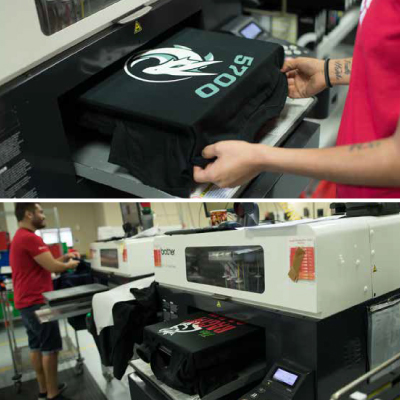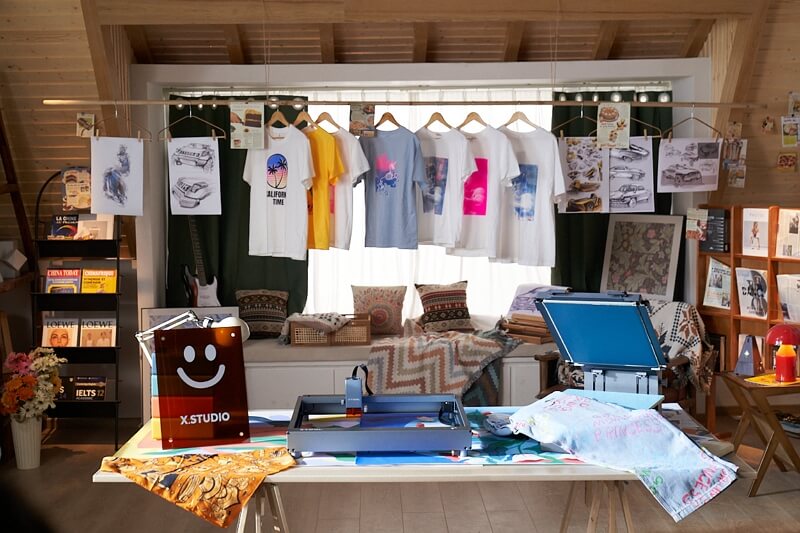How Tx Tees can Save You Time, Stress, and Money.
About Tx Tees
Table of Contents8 Easy Facts About Tx Tees ExplainedAbout Tx TeesExcitement About Tx TeesGetting My Tx Tees To WorkA Biased View of Tx TeesAn Unbiased View of Tx TeesA Biased View of Tx Tees
Add up various other expenses, like the number of energies it takes to run the shop and the price of ink and emulsion per layout. Take the print below.The emulsion ought to just be a couple of cents since you 'd only need to layer one display for this work. So just how much should you charge per tee shirt to earn a profit? Usually, printers attempt to make up to 45% profit on a print job. Here's a table to assist you figure out that: complete price per thing percent of desired profit as a decimal (example:.25 or.45) profit made per thing per work Currently allowed's speak about the earnings of DTF.

With DTF, you can print a handful of t shirts, or just one. Use the very same calculator as the area above to calculate just how much revenue you 'd use DTF transfers. Contrast the costs and profits to whichever approach speaks ideal to your arrangement and process. Both display printing and DTF have their specific niches in the world.
Things about Tx Tees
The very best way to understand? Ask about and see what print shops like your own are doing. screen printer. Attempt both out and see which you like far better
When you're choosing what sort of printing technique to utilize for publishing your art work layouts on your garments, it is necessary that you understand the differences in between these 2 strategies so you can make the most of results while reducing expenses. Screen printing is the most frequently utilized method for publishing styles on textiles.
DTG printing is likewise referred to as area or direct to garment printing since it prints only what is needed rather than making a display as display printers do. https://hub.docker.com/u/txtees02. Display printing works by screen filler squeegee display printing ink screen mesh display, then moving the image to garment utilizing warm and/or stress
The DTG printer utilizes unique dye-sublimation inks that are applied right into a pre-designed image by an electronic printing system. The inks end up being component of the fabric, permitting dynamic shades and extraordinary information. It's likewise referred to as spot or straight to garment printing due to the fact that it prints just what is required instead of making a display as display printers do.
Some Known Incorrect Statements About Tx Tees
It's much faster - you can print a fullcolor picture in minutes, as opposed to hours for screen printing. Second, there's no set up time or costs entailed - you can publish any kind of layout you such as, without having to develop a screen initially. Third, there's no waste - because screen printers display print one layout each time, they need to evaluate each shade separately.
The paper is very expensive and can only be made use of as soon as. Once it's published on, it needs to be thrown out. - The first acquisition rate is less than the ahead of time investment of DTG printers- You can print multi-color designs one screen at once rather of needing to print each color separately like DTG printing.

Some Of Tx Tees
Nonetheless, instead of using screen mesh as screen printers do, color sublimation printers use laser modern technology to transfer your pictures onto garments or paper. A warm procedure moves the color from its solid-state straight into the gas stage which in turn fuses it onto textile substratums when they are swiftly warmed to high temperature levels under high pressure.
Sublimation printing is environmentally friendly. It utilizes much less water than screenprinting, and due to the fact that it doesn't include making use of hazardous solvents, it's risk-free for all sorts of clothing. The color sublimation inks are additionally odorless when cured, unlike display printers that make use of unsafe chemicals during the screen printing process that leave behind an unpleasant odor.
They likewise save money on costly equipment like direct exposure units since dye sublimation printers don't require a UV exposure unit or a flash cure oven that is generally used in display printing (embroidery shop). What is straight to garment printing (DTG Printing)? DTG printing is an electronic screenprinting process that prints straight onto textile making use of specialized inkjet printers
The Best Guide To Tx Tees
DTG printing uses many benefits over typical visit this website screenprinting, including the ability to publish photographic quality photos, greater shade vibrancy, and the capability to publish layouts on darker fabrics. DTG printers function by heating up the fabric ink till it transforms right into a gas. The gas then permeates the material, bonding with the fibers to develop a long-term print.

Display printers just prepare their display after that begin publishing till they lack product or ink.- There is a vast array of skilled screen printers all over the globe, which can be helpful for newbies. - It's a slower procedure - screen printers typically have to wait for the ink to completely dry prior to they can print the next shade- Display printers need hands-on labor, so there's a higher understanding contour and it takes longer to create a premium design- Display printing isn't as exact as DTG printing, so you may get some "blood loss" of colors from one part of the photo onto one more if not done effectively.
All about Tx Tees
Rather of using display mesh as screen printers do, dye sublimation printers make use of laser technology to move your photos onto garments or paper. A warm procedure moves the dye from its solid-state directly into the gas phase which subsequently integrates it onto fabric substrates when they are quickly heated to heats under high pressure.
Sublimation printing is green. It uses much less water than screenprinting, and due to the fact that it doesn't include the usage of hazardous solvents, it's secure for all kinds of apparel. The dye sublimation inks are likewise odorless when cured, unlike screen printers that make use of harmful chemicals during the screen printing process that leave an undesirable odor.
They also save money on expensive tools like direct exposure units because dye sublimation printers don't need a UV direct exposure device or a flash treatment stove that is typically used in display printing. What is straight to garment printing (DTG Printing)? DTG printing is an electronic screenprinting procedure that publishes directly onto fabric using specialized inkjet printers.
The Tx Tees Ideas
DTG printing provides numerous benefits over typical screenprinting, consisting of the capability to print photographic top quality pictures, better color vibrancy, and the ability to publish designs on darker materials. DTG printers work by heating the textile ink until it turns into a gas. The gas then penetrates the material, bonding with the fibers to produce a permanent print.